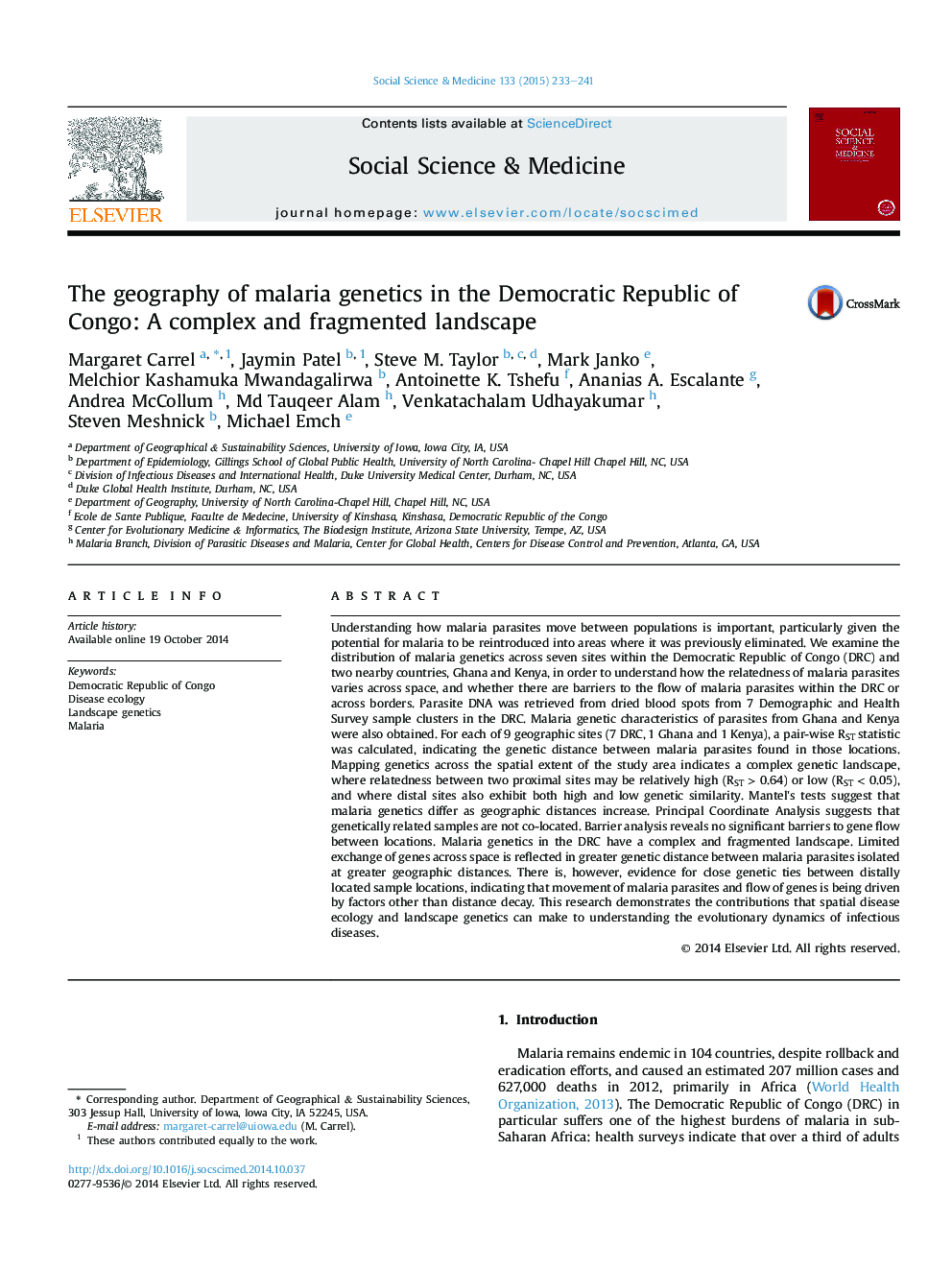| کد مقاله | کد نشریه | سال انتشار | مقاله انگلیسی | نسخه تمام متن |
|---|---|---|---|---|
| 7332441 | 1476035 | 2015 | 9 صفحه PDF | دانلود رایگان |
عنوان انگلیسی مقاله ISI
The geography of malaria genetics in the Democratic Republic of Congo: A complex and fragmented landscape
ترجمه فارسی عنوان
جغرافیا ژنتیک مالاریا در جمهوری دموکراتیک کنگو: چشم انداز پیچیده و تقسیم شده
دانلود مقاله + سفارش ترجمه
دانلود مقاله ISI انگلیسی
رایگان برای ایرانیان
کلمات کلیدی
جمهوری دموکراتیک کنگو، بوم شناسی بیماری، ژنتیک چشم انداز، مالاریا،
موضوعات مرتبط
علوم پزشکی و سلامت
پزشکی و دندانپزشکی
سیاست های بهداشت و سلامت عمومی
چکیده انگلیسی
Understanding how malaria parasites move between populations is important, particularly given the potential for malaria to be reintroduced into areas where it was previously eliminated. We examine the distribution of malaria genetics across seven sites within the Democratic Republic of Congo (DRC) and two nearby countries, Ghana and Kenya, in order to understand how the relatedness of malaria parasites varies across space, and whether there are barriers to the flow of malaria parasites within the DRC or across borders. Parasite DNA was retrieved from dried blood spots from 7 Demographic and Health Survey sample clusters in the DRC. Malaria genetic characteristics of parasites from Ghana and Kenya were also obtained. For each of 9 geographic sites (7 DRC, 1 Ghana and 1 Kenya), a pair-wise RST statistic was calculated, indicating the genetic distance between malaria parasites found in those locations. Mapping genetics across the spatial extent of the study area indicates a complex genetic landscape, where relatedness between two proximal sites may be relatively high (RSTÂ >Â 0.64) or low (RSTÂ <Â 0.05), and where distal sites also exhibit both high and low genetic similarity. Mantel's tests suggest that malaria genetics differ as geographic distances increase. Principal Coordinate Analysis suggests that genetically related samples are not co-located. Barrier analysis reveals no significant barriers to gene flow between locations. Malaria genetics in the DRC have a complex and fragmented landscape. Limited exchange of genes across space is reflected in greater genetic distance between malaria parasites isolated at greater geographic distances. There is, however, evidence for close genetic ties between distally located sample locations, indicating that movement of malaria parasites and flow of genes is being driven by factors other than distance decay. This research demonstrates the contributions that spatial disease ecology and landscape genetics can make to understanding the evolutionary dynamics of infectious diseases.
ناشر
Database: Elsevier - ScienceDirect (ساینس دایرکت)
Journal: Social Science & Medicine - Volume 133, May 2015, Pages 233-241
Journal: Social Science & Medicine - Volume 133, May 2015, Pages 233-241
نویسندگان
Margaret Carrel, Jaymin Patel, Steve M. Taylor, Mark Janko, Melchior Kashamuka Mwandagalirwa, Antoinette K. Tshefu, Ananias A. Escalante, Andrea McCollum, Md Tauqeer Alam, Venkatachalam Udhayakumar, Steven Meshnick, Michael Emch,
